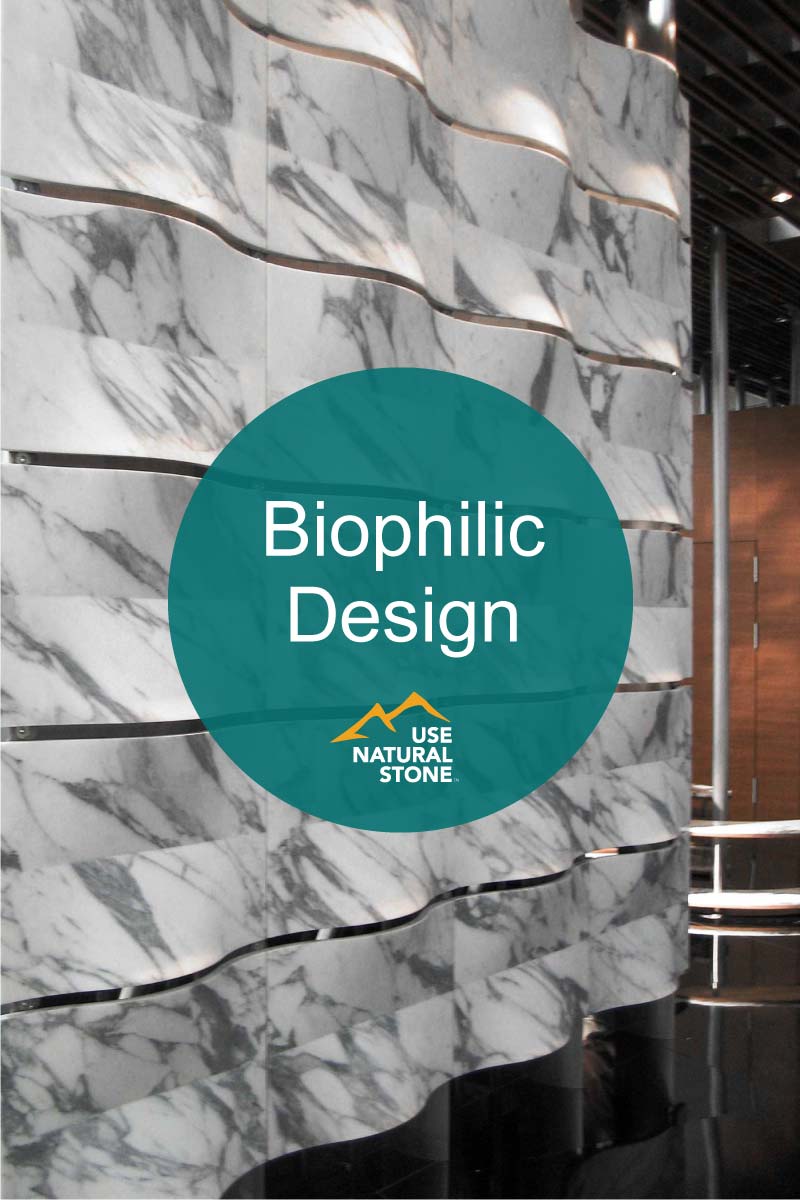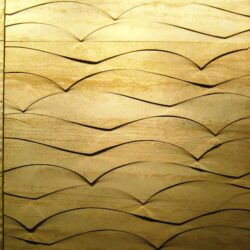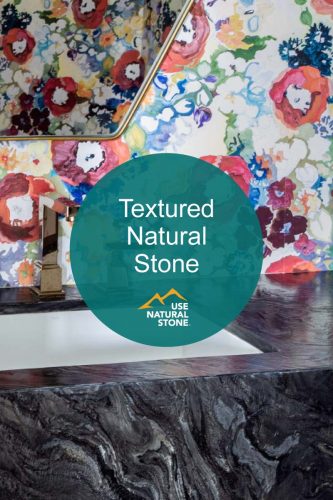Using Natural Stone in Biophilic Design
Designing for Health and Well-Being
The last few years have put a laser focus on the importance of our health and well-being. With so much time spent working from home, tending to our basic needs, and finding a new balance, it is essential that the places where we spend our time also support our physical and emotional health and well-being. How can you design or remodel your home to achieve these goals? Biophilic design can help you tap into an innate connection with nature to achieve these goals successfully.
It has long been known that time spent in nature can reduce stress, increase creativity, improve well-being, and even expedite healing. Biophilic design uses this knowledge in the building design process. Biophilic design concepts have been applied to projects for many years, but the research and body of evidence demonstrating its effectiveness are growing rapidly. Even green building rating systems have added biophilic design to their programs because of this expanded understanding. Knowing there will be real benefits and positive results makes it easier to implement these concepts in your own project. This article will explore a few of the concepts and research behind this movement and showcase ways natural stone can be used in biophilic design, whether as a main design feature or a supporting element.

This beautiful setting in northern Italy is also the location of a granite quarry that is operated in harmony with these natural resources. Photo courtesy of Stephanie Vierra.
What is Biophilic Design?
Biophilic design is a way to connect people and nature through design with elements that nurture the innate human-nature connection1. Good biophilic design respects the mind-body systems as indicators of health and well-being in the context of what is locally appropriate and responsive2. It draws from many perspectives to create spaces that are inspirational, restorative, heathy, and functional. Most importantly, biophilic design should nurture a love of place, something natural stone projects have been doing for thousands of years.
We must first look to nature to understand some of these principles. In the context of biophilic design, nature is defined as all living organisms and non-living components of an ecosystem; from the sun, moon, forests, and plants, to animals and even urban raingardens.
Nature-Health relationships help explain how people’s health and well-being are impacted by their environment. Strong or even routine connections with nature provide opportunities for mental restoration, improving mental agility, memory, and the ability to think and learn. Research also shows that time in natural environments provides greater emotional restoration and improves mood, concentration, and adaptability. It also lowers tension, anxiety, anger, fatigue, and confusion. Our muscles tend to relax and blood pressure goes down when spending time in nature.
Nature-Design relationships provide a framework for understanding and the thoughtful incorporation of various strategies into the built environment. Whenever possible, the design should provide direct connections to nature through views and stimulus such as sounds, plants, water, the air and temperature, light and shadows, or an entire ecosystem. If there is no direct access to nature, beneficial results can still be achieved using materials, shapes, colors, sequences, and patterns found in nature. The materials can also reflect the local ecology or geology to create a distinct sense of place. Other design patterns can be used to create mystery, refuge, or the feeling of risk in or around a space to create a sense of excitement and wonder. These approaches can help you create a quiet place to retreat or encourage deeper travel into an environment.

Immersion in nature is experienced via a natural stone staircase from the Hyakusaiji Temple in Japan.
Using Natural Stone to Achieve Biophilic Design Goals
For centuries, natural stone has been used for its durability, strength, and aesthetics. Natural stone was often quarried near a project, so people associated the material with the specific place. Some of the oldest stone buildings are still sought after for the effect they have on people and their strong sense of place. Ancient stone buildings were constructed using patterns in nature that were translated to mathematical proportions. For example, the Egyptian Pyramids, the Parthenon, Notre Dame, and the Taj Mahal all incorporated aspects of the Golden Mean, a ratio that shows up in plants like sunflowers and the spiral of seashells. The patterns and arrangements of these buildings became symbolic representations of the natural world.
The spiral, a pattern commonly found in nature such as in sunflowers and seashells, is often incorporated into building design.
Research demonstrates that people prefer real materials over synthetic variations because human receptors can tell the difference between them. Natural stone has different patterns, veining, and textures, and many contain fossils, which also help make connections to nature and its processes. These same qualities can also be achieved or simulated through fabrication and finishing techniques to include interesting textures, patterns, and elements that mimic nature.
These are all great reasons to use natural stone to meet biophilic design goals. Whether you are designing a terrace, home library or office, spa-like bathroom, outdoor fountain, garden, or retreat space, biophilic design principles and patterns can be applied no matter the size, type, or location of the project.
- Ammonites, fossils of extinct marine animals, appear quite frequently in natural stones. They make a great connection to a natural material and process. Photo Credit: Stephanie Vierra,
- Jerusalem limestone with the highest content of fossils was chosen for the lobby walls of a bank and intentionally placed at corners where it would be encountered frequently and touched by passersby. Flooring is Israel Kashmire white granite. Photo Credit: COOKFOX Architects.
To begin, the project needs to be well defined and include biophilic design as a goal. The health priorities of the intended users should be considered. Will the space directly connect to nature, or will the project incorporate elements and patterns of nature? How will the space be used: is it meant to restore, calm, stimulate, or some combination of these things?
Natural stone can play an important role in connecting to nature. Consistent use of natural stone for exterior and interior flooring can create a seamless connection between spaces and blur the distinction between inside and out, further enhancing the link and access to nature. If there is no view to nature available, the design should include natural materials and other elements that evoke nature. Take advantage of stone’s wide range of natural textures or create them through the fabrication process.
Touching the texture of a natural material like stone can bring tranquility. Incorporate natural stone into a fireplace or firepit to support the connection to the sensations experienced with a crackling fire. Consider selecting a natural stone that includes fossils to provide a connection to natural processes.

This outdoor fire pit using natural stone provides both the texture and feel of a natural material and the presence of fire which can be very captivating. Photo Credit: PaveStone Brick Paving, Inc.
Spaces need to feel comfortable, and research has shown that thermal comfort is a great bridge between biophilic design and sustainable design. Because many natural stones perform consistently through wide temperature changes and store and release heat slowly, they can help improve thermal performance to create this sense of comfort. Stone can also warm or cool feet and hands through conductance, which is when heat moves between two objects that are in direct contact with each other. Use stone for walls, an exterior façade, and flooring materials for this passive solar design strategy and combine it with daylight strategies to create comfortable spaces. Light colored stones reflect light and heat and can help achieve this level of comfort as well. This is especially useful in areas with extreme temperatures or little water since lighter colored stone can also reduce water loss through evaporation.
Another aspect of biophilic design is connecting to natural systems. This can include seasonal or temporal changes that make the user aware of the seasons and cycles of life. The experience is known to be relaxing, nostalgic, and even profound. Natural stone can help support this goal because of its visible geological features. The natural patina of stone, especially an exterior stone that is allowed to weather naturally, can also support this idea. Patina can also be simulated through the fabrication and finishing of the stone.
Research demonstrates that people have a visual preference for organic and biomorphic forms, which are contoured, patterned, textured, or numerical arrangements. These forms and patterns that persist in nature are a great way to create biophilic spaces that feel interesting, comfortable, contemplative, or even absorptive. Even though the brain knows that these forms in design are not living things, they appear to be symbolic representations of life and have a positive effect on people. Incorporate natural stone to achieve this goal by taking advantage of the many ways that natural stone can also be cut, fabricated, and finished.
For example, nature typically does not have right angles or straight lines. Consider a soft smooth edge or a curved form instead of one with all straight lines. Create a sequence of design elements that repeat in a rhythmic manner or incorporate natural elements into the material such as flowers, shells, or leaves. These strategies should be applied on 2 or 3 planes or dimensions, for example on floors and walls or windows and soffits, giving the user more exposure to the patterns and forms. This frequency of exposure helps reduce stress and enhance concentration.
Interestingly, research also demonstrates that there needs to be a balance between spaces being boring and overwhelming in order to feel engaged and visually nourished. Natural stone achieves this by its very nature and is another reminder that synthetic materials with little or no pattern, veining, or texture will not have the same positive psychological or cognitive response. The desired balance is very personal and requires some experimentation to determine what feels right for the design and users of the space.
These uniquely curved and rhythmic patterns with natural stone were achieved through the fabrication process. Waves in the sea inspired the design of the stone panel in the middle. Photos courtesy of Stephanie Vierra.
Combining biophilic strategies can have an even greater impact on the effectiveness of the design. Many of the strategies complement or support the others. The strategies will also be more cost-effective if they are introduced early in the design process. That gives you time to consider all the options and plan for the long-term use and care of these design elements. Now more than ever, it is important to reconnect to nature. Our health and well-being depend on it. Biophilic design can help us make great strides in restoring this innate human-nature connection. Natural stone has been a part of this approach throughout history and will continue to support the need to be in touch with our relationship to nature and the many benefits it provides.
Left to Right: The Parthenon, Pantheon, and Notre Dame; examples of ancient natural stone design that incorporated elements and patterns in nature; among the reasons they still have such a powerful and positive impact on our senses.
These are just a few of the ways in which natural stone can support biophilic design. To further explore the possibilities, check out the resources below, which informed much of this article and offer more detailed explanations of the concepts and research supporting this movement.
Endnotes
1) Biophilic Design Initiative of the International Living Future Institute
2) 14 Patterns of Biophilic Design: Improving Health & Well-Being in the Built Environment














